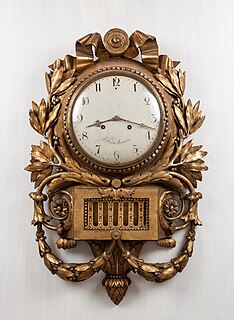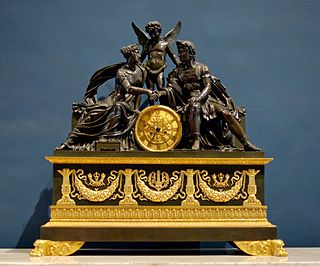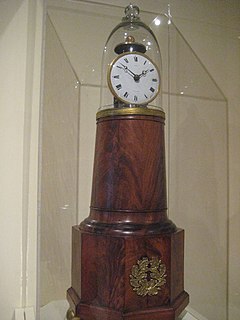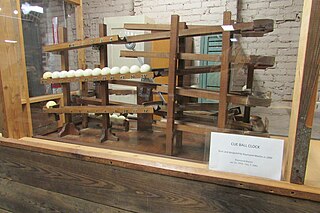 W
WAn Act of Parliament clock, also commonly known as a tavern clock, is a type of large clock originally hung in inns and taverns in the United Kingdom, beginning in the mid-18th century. Such clocks were plain in design, the faces were around two to five feet in diameter, and they were hung on the wall.
 W
WAn alarm clock is a clock that is designed to alert an individual or group of individuals at a specified time. The primary function of these clocks is to awaken people from their night's sleep or short naps; they are sometimes used for other reminders as well. Most use sound; some use light or vibration. Some have sensors to identify when a person is in a light stage of sleep, in order to avoid waking someone who is deeply asleep, which causes tiredness, even if the person has had adequate sleep. To turn off the sound or light, a button or handle on the clock is pressed; most clocks automatically turn off the alarm if left unattended long enough. A classic analog alarm clock has an extra hand or inset dial that is used to specify the time at which the alarm will ring. Alarm clocks are also used in mobile phones, watches, and computers.
 W
WDuring the 1600s, when metal was harder to come by in the colonies than wood, works for many American clocks were made of wood, including the gears, which were whittled and fashioned by hand, as were all other parts. There is some evidence that wooden clocks were being made as early as 1715 near New Haven. Benjamin Cheney of East Hartford, Connecticut, was producing wooden striking clocks by 1745.
 W
WAn automaton clock or automata clock is a type of striking clock featuring automatons. Clocks like these were built from the 1st century BC through to Victorian times in Europe. A Cuckoo clock is a simple form of this type of clock.
 W
WA balloon clock is a bracket clock with a waisted or balloon-shaped case. It was popular in England from the late 18th to the early 19th century.
 W
WThe banjo clock, or banjo timepiece, is an American wall clock with a banjo-shaped case. It was invented by Simon Willard, originally of Grafton, Massachusetts, later of Roxbury, Massachusetts, and patented in 1802. The banjo clock normally lacks a striking mechanism and indicates time only by its hands and dial, for which reason some horologists may insist upon calling it a timepiece rather than a true clock. In popular usage though, no such distinction is made.
 W
WA bracket clock is a style of antique portable table clock made in the 17th and 18th centuries. The term originated with small weight-driven pendulum clocks that had to be mounted on a bracket on the wall to allow room for their hanging weights. When spring-driven clocks were developed, which didn't require hanging weights to power them, they continued to be made in the bracket style. Often they are composed of two matching pieces created as an ensemble: the clock and its small decorative shelf. They are almost always made of wood, often ebony, and often ornamented with ormolu mounts, brass inlay, wood or tortoise shell veneer, or decorative varnish. Since in their day clocks were expensive, and a household would not have one in every room, bracket clocks usually had handles to carry them from room to room.
 W
WA carriage clock is a small, spring-driven clock, designed for travelling, developed in the early 19th century in France, where they were also known as "Officers' Clocks". The first carriage clock was invented by Abraham-Louis Breguet for the Emperor Napoleon in 1812. The case, usually plain or gilt-brass, is rectangular with a carrying handle and often set with glass or more rarely enamel or porcelain panels. A feature of carriage clocks is the platform escapement, sometimes visible through a glazed aperture on the top of the case. Carriage clocks use a balance and balance spring for timekeeping and replaced the larger pendulum bracket clock. The factory of Armand Couaillet, in Saint-Nicolas d'Aliermont (France) made thousands of carriage clocks between 1880 and 1920.
 W
WA cartel clock is a cartouche shaped clock designed to hang directly on a wall, very commonly executed in fire-gilt bronze. The form is a more unified development from a wall-mounted bracket clock standing upon its separate, complementary bracket characteristic of the Régence (1715–23), which continued to be stylish in Paris through the 1740s. In Paris, where the ébéniste's wooden contribution to the case and wall bracket, conceived as complements in design, was by degrees overshadowed by gilt-bronze mounts. wholly gilt-bronze bracket clock cases became most common by ca 1730. The cartel clock, incorporating clock case and bracket in a single unified organic sculptural conception, was a Rococo invention initiated in Paris. Highly ornate Rococo examples exist, with flowing, asymmetrical and curvilinear designs, the most notable being a series of unified cartel clocks in half a dozen related models, dateable to the 1730s and 40s and attributed to Charles Cressent.
 W
WA chariot clock is a type of mantel/table figural clock in the form of a chariot whose dial is set into the wheel or elsewhere, its origins date back to the second half of the 16th century southern Germany. Normally of classical mythology subject matter, it has been made in different periods and styles such as Renaissance, Louis XV, Louis XVI, Empire, Napoleon III, Art Deco, etc.
 W
WClocky is a brand of alarm clock outfitted with wheels, allowing it to hide itself in order to force the owner awake in an attempt to find it. Invented for an industrial design class by Gauri Nanda, then a graduate student at MIT Media Lab, Clocky won the 2005 Ig Nobel Prize in Economics. After earning her undergraduate degree from the University of Michigan and her master's degree from MIT, Nanda founded a company, Nanda Home, to commercialize Clocky and other home products.
 W
WA Congreve clock is a type of clock that uses a ball rolling along a zigzag track rather than a pendulum to regulate the time. It was invented by Sir William Congreve in 1808. The ball takes between 15 seconds and one minute to run down the zigzag track, where it trips the escapement which in turn reverses the tilt of the tray and at the same time causes the hands of the clock to move forward. Thus the angle of the plate reverses and the clock hands move forward between one and four times every minute. On versions of the clock with a dial to indicate seconds, the second hand jumps forward either 15 or 30 seconds on each oscillation depending on the length of the track.
 W
WA cuckoo clock is, typically, a pendulum clock that strikes the hours with a sound like a common cuckoo call and has an automated cuckoo bird that moves with each note. Some move their wings and open and close their beaks while leaning forwards, whereas others have only the bird's body leaning forward. The mechanism to produce the cuckoo call has been in use since the middle of the 1700s and has remained almost without variation.
 W
WA digital clock is a type of clock that displays the time digitally, as opposed to an analogue clock.
 W
WJakob Friedrich Eisenlohr was a German architect and university professor. His design for a cuckoo clock, now known as the Bahnhäusle style, was the first to be mass-produced and helped make the clocks popular outside of Germany.
 W
WAn electric clock is a clock that is powered by electricity, as opposed to a mechanical clock which is powered by a hanging weight or a mainspring. The term is often applied to the electrically powered mechanical clocks that were used before quartz clocks were introduced in the 1980s. The first experimental electric clocks were constructed around the 1840s, but they were not widely manufactured until mains electric power became available in the 1890s. In the 1930s the synchronous electric clock replaced mechanical clocks as the most widely used type of clock.
 W
WA flip clock is an electromechanical, digital time keeping device with the time indicated by numbers that are sequentially revealed by a split-flap display. The study, collection and repair of flip clocks is termed horopalettology [From horology - The study and measurement of time and palette - from the Italian "orologio a palette" - Italian for "flip clock"]. People interested in the collection, restoration, buying and selling of flip clocks are known as horopalettologists.
 W
WA floral clock, or flower clock, is a large decorative clock with the clock face formed by carpet bedding, usually found in a park or other public recreation area. Most have the mechanism set in the ground under the flowerbed, which is then planted to visually appear as a clock face with moving arms which may also hold bedding plants.
 W
WA flying pendulum clock is a clock that uses a flying pendulum escapement mechanism. A small metal ball, connected by string wraps around one brass post, then unwinds before repeating on the other brass post.
 W
WA French Empire-style mantel clock is a type of elaborately decorated mantel clock that was made in France during the Napoleonic Empire (1804–1814/15). Timekeepers manufacturing during the Bourbon Restoration (1814/1815–1830) are also included within this art movement as they share similar subjects, decorative elements, shapes, and style.
 W
WHexadecimal time is the representation of the time of day as a hexadecimal number in the interval [0,1).
 W
WA Japanese clock is a mechanical clock that has been made to tell traditional Japanese time, a system in which daytime and nighttime are always divided into six periods whose lengths consequently change with the season. Mechanical clocks were introduced into Japan by Jesuit missionaries or Dutch merchants. These clocks were of the lantern clock design, typically made of brass or iron, and used the relatively primitive verge and foliot escapement. Tokugawa Ieyasu owned a lantern clock of European manufacture.
 W
WThe Kit-Cat Klock is an art deco novelty wall clock shaped like a grinning cat with cartoon eyes that swivel in time with its pendulum tail. It is traditionally black, but models in other colors and styles are available. It is an iconic symbol of kitchens in pop culture.
 W
WA lantern clock is a type of antique weight-driven wall clock, shaped like a lantern. They were the first type of clock widely used in private homes. They probably originated before 1500 but only became common after 1600; in Britain around 1620. They became obsolete in the 19th century.
 W
WA lighthouse clock is a type of mantel clock manufactured in the U. S. from 1818 through 1830s by the American clockmaker Simon Willard, having the dial and works exposed beneath a glass dome on a tapered, cylindrical body.
 W
WMantel clocks—or shelf clocks—are relatively small house clocks traditionally placed on the shelf, or mantel, above the fireplace. The form, first developed in France in the 1750s, can be distinguished from earlier chamber clocks of similar size due to a lack of carrying handles.
 W
WThe monstrance clock, or mirror clock, is a type of clock that was developed during the Renaissance. It is cross-shaped and typically either gold or silver in colour but can feature both colours. They used to play an important part in a church ritual and often incorporated sacred figures as part of the design. The clock made use of a rotating ball at the top or in the base to indicate the time of day. Monstrance clocks and crucifix clocks remained fashionable until the eighteenth century.
 W
WA musical clock is a clock that marks the hours of the day with a musical tune. They can be considered elaborate versions of striking or chiming clocks.
 W
WA Nuremberg egg is a type of small ornamental spring-driven clock made to be worn around the neck, produced in Nuremberg in the mid-to-late 16th century.
 W
WA pendulum clock is a clock that uses a pendulum, a swinging weight, as its timekeeping element. The advantage of a pendulum for timekeeping is that it is a harmonic oscillator: It swings back and forth in a precise time interval dependent on its length, and resists swinging at other rates. From its invention in 1656 by Christiaan Huygens, inspired by Galileo Galilei, until the 1930s, the pendulum clock was the world's most precise timekeeper, accounting for its widespread use. Throughout the 18th and 19th centuries, pendulum clocks in homes, factories, offices, and railroad stations served as primary time standards for scheduling daily life, work shifts, and public transportation. Their greater accuracy allowed for the faster pace of life which was necessary for the Industrial Revolution. The home pendulum clock was replaced by less-expensive, synchronous, electric clocks in the 1930s and '40s. Pendulum clocks are now kept mostly for their decorative and antique value.
 W
WA rolling ball clock is a clock which displays time by means of balls and rails.
 W
WA sundial is a horological device that tells the time of day when there is sunlight by the apparent position of the Sun in the sky. In the narrowest sense of the word, it consists of a flat plate and a gnomon, which casts a shadow onto the dial. As the Sun appears to move across the sky, the shadow aligns with different hour-lines, which are marked on the dial to indicate the time of day. The style is the time-telling edge of the gnomon, though a single point or nodus may be used. The gnomon casts a broad shadow; the shadow of the style shows the time. The gnomon may be a rod, wire, or elaborately decorated metal casting. The style must be parallel to the axis of the Earth's rotation for the sundial to be accurate throughout the year. The style's angle from horizontal is equal to the sundial's geographical latitude.
 W
WA Sector clock or colour change clock was a round colour-coded clock used at military airfields and observation posts in the United Kingdom to help track the movements of enemy aircraft and control friendly aircraft.
 W
WThe Shortt–Synchronome free pendulum clock was a complex precision electromechanical pendulum clock invented in 1921 by British railway engineer William Hamilton Shortt in collaboration with horologist Frank Hope-Jones, and manufactured by the Synchronome Co., Ltd. of London, UK. They were the most accurate pendulum clocks ever commercially produced, and became the highest standard for timekeeping between the 1920s and the 1940s, after which mechanical clocks were superseded by quartz time standards. They were used worldwide in astronomical observatories, naval observatories, in scientific research, and as a primary standard for national time dissemination services. The Shortt was the first clock to be a more accurate timekeeper than the Earth itself; it was used in 1926 to detect tiny seasonal changes in the Earth's rotation rate. Shortt clocks achieved accuracy of around a second per year, although a recent measurement indicated they were even more accurate. About 100 were produced between 1922 and 1956.
 W
WSony Dream Machine was Sony Electronics' long-running line of clock radios. Models ranged from basic AM/FM models to more expensive models sporting iPod/iPhone docking, a LCD screen, and internet connectivity.
 W
WA street clock or post clock is a clock mounted on top of a post typically installed in a streetscape or other urban or park setting.
 W
WA torsion pendulum clock, more commonly known as an anniversary clock or 400-day clock, is a mechanical clock which keeps time with a mechanism called a torsion pendulum. This is a weighted disk or wheel, often a decorative wheel with 3 or 4 chrome balls on ornate spokes, suspended by a thin wire or ribbon called a torsion spring. The torsion pendulum rotates about the vertical axis of the wire, twisting it, instead of swinging like an ordinary pendulum. The force of the twisting torsion spring reverses the direction of rotation, so the torsion pendulum oscillates slowly, clockwise and counterclockwise. The clock's gears apply a pulse of torque to the top of the torsion spring with each rotation to keep the wheel going. The Atmos Clock made by the Swiss company Jaeger-LeCoultre is another style of this clock. The wheel and torsion spring function similarly to a watch's balance wheel and hairspring, as a harmonic oscillator to control the rate of the clock's hands.
 W
WA turret clock or tower clock is a clock designed to be mounted high in the wall of a building, usually in a clock tower, in public buildings such as churches, university buildings, and town halls. As a public amenity to enable the community to tell the time, it has a large face visible from far away, and often a striking mechanism which rings bells upon the hours.
 W
WThe Watch 1505 is the world's first watch. It was crafted by the German inventor, locksmith and watchmaker Peter Henlein from Nuremberg, during the year 1505, in the early German Renaissance period, as part of the Northern Renaissance. However, other German clockmakers were creating miniature timepieces during this period, and there is no definite evidence Henlein was the first. It is the oldest watch in the world that still works. The watch is a small fire-gilded copper sphere, an oriental pomander, and combines German engineering with Oriental influences. In 1987, the watch reappeared at an antiques and flea market in London. The initial price estimation for this watch is between 50 and 80 million dollars.